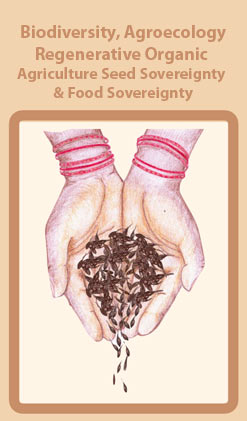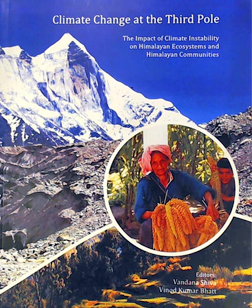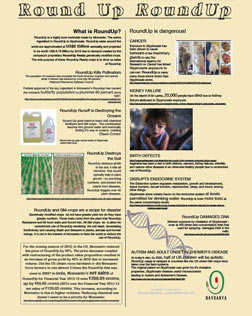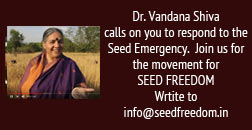Recurrent Climate related Disasters posing serious threats to Agriculture and Biodiversity
Climate change is not just a problem for the future. It is impacting us every day, everywhere. Climate change has resulted in an increase in droughts, floods, and tropical cyclones- what are known as “extreme events”. is increase has already begun. Extreme droughts, extreme floods, and extreme cyclones are part of the destabilisation of the climate due to green- house gases.
e snowfall period in the mountains has shrunk by 8 to 10 days in the past 10 years and snowfall has become intermittent. Monsoon rains have become quite erratic and winter rains are now not only scarce but are quite erratic. Extended summers in the high mountainous regions are changing the ecology of the region. The intensity and frequency of hurricanes and cyclones is increasing. Asia was hit by the Odisha super cyclone in 1998; it killed 30,000. In November 2007, Cyclone Sidr hit Bangladesh with wind speeds of 260 kilometres per hour; it killed 4,400 and displaced 4 million. In May 2008, Cyclone Nargis devastated Myanmar. At least 84,537 people were killed and another 53,836 went missing. e intensity of Hurricane Katrina, which devastated the Gulf Coast in August 2005, is also linked to climate change. e higher the speed of a cyclone, the more destructive is its force. Globally, category 4 and 5 storms were 50 percent more frequent between 1990 and 2004 than they were between 1975 and 1989.
In 2003, a heat wave in August led to the deaths of 50,000 people in Europe, including 13,000 in France. Nine hundred died in England, more than 1,300 in Portugal, 8,600 in Spain, 4,600 in Netherlands, and 1,000 in Germany and Switzerland. Italy, which initially reported 8,000 deaths, later raised its death toll to 20,000
In January 2008, unprecedented snowstorms crippled China. Sixty centimetres of snow covered parts of Xinjiang. More than 100,000 people were evacuated a er their homes collapse under heavy snow. Temperatures plummeted to 43 degrees below zero Celsius. Twenty –one people died; 5,000 people were treated for frostbite.
Extreme events like heavy rains, cloud burst, cyclones etc. have grown both in number and intensity in India in the space of half a century. An analysis of rainfall during monsoon season from 1951 to 2000 in an area of about 1.4 million square kilometres in Central India shows that episodes of “heavy” rainfall (10 centimetres or more of rain in a single day) had increased at the rate of 10 percent per decade. Instances of “very heavy” rainfall (15 centimetres of more of rain in a day) more than doubled between 1951 and 2000. In addition, the average intensity of the four heaviest rain events during each monsoon had grown from 18 centimetres in 1951 to 26 centimetres in 2000. empirical tends have been modelled by the Pune – based Indian Institute of Tropical Meteorology and they t with climate change projections.
In the year 2006 intense rain claimed several hundred lives in Jaisalmer and Barmer districts of Rajasthan. In the month of August 2010, Leh, Jammu and Kashmir witnessed ‘cloud burst’ where at least 225 were dead. In the year 2013, four border districts of Uttarakhand state received more than 400% rainfall in a span of three days from 15th till 17th June, which killed about 20,000 people and resulted in huge damage to property, houses and crops.
Phailin, a Severe Cyclonic Storm as powerful hurricane Katrina, devastated Odisha in the month of October 2013 causing substantial damage in parts of Andhra Pradesh. Phailin is believed to be the most intense cyclone that crossed Indian coast a er the 1999 Odisha Super Cyclone. More than 12 million people had been hit by the gale in 17968 Villages across 17 districts. Phailin rendered 3.7 lakh people homeless. About 3.6 million hectares of cultivable land, 0.5 mil- lion was badly affected causing damage of more than Rs. 2400 crore to kharif paddy. It also damaged 7500 telephone towers.
In September, 2014, floods and rain in Jammu and Kashmir claimed more than 300 lives, affected about 1.25 million people and damaged nearly three lakh houses in the state. e loss to the state economy was estimated to be about one lakh crore. More than 300 ninety thousand animals were also perished. Rain broke the previous records of the state by receiving more than double rainfall in short span of time. the flood is reported as the worst in 110 years.
In October 2014, Cyclone Hudhud wreaked havoc in four districts of Andhra Pradesh, Vishakhapatnam, Srikakulam, Vizianagram and East Godavari. As per the state government about 2.48 lakh people were affected killing 144 people. It caused loss of more than 21000 crore to public property. Agriculture loss was about Rs. 2000 crore. More than 1 lakh houses were damaged.
The 2015 Gujarat cyclone (Deep Depression ARB 02) in June 2015 brought heavy rains to the state of Gujarat that resulted in floods. The floods resulted in at least 80 deaths. e wild life of Gir Forest National Park and the adjoining area was also affected. The heavy rainfall during November–December 2015 badly affected the Coromandel Coast region of the South Indian states of Tamil Nadu and Andhra Pradesh, and the union territory of Puducherry. e city of Chennai particularly hard-hit and more than 500 people were killed and over 18 lakh (1.8 million) people were displaced. Damages and losses estimated to be ranging between Rs. 50000 crore (US$7 billion) to Rs.100000 crore (US$15 billion)
Heavy rains in July 2015 Gujarat was affected by the flood by killing at least 72 deaths and over 81,609 cattle in three districts; Banaskantha, Patan and Kutch. e property worth Rs 2000 crore was completely damaged or washed away as per government estimate. e crops in about 2 lakh hectares failed. In three days Kutch and Banaskantha district recorded over 100 per cent of annual average rainfall, whereas in some areas like Suigam, recorded 510 per cent of the total annual average rainfall.
In the month of August 2015 by heavy rainfall floods were triggered through the river Brahmaputra and its tributaries in Assam and Arunachal Pradesh state. The floods affected 1.65 million people in 21 districts as a result 42 people died. Flooding caused numerous landslides and road blockages affecting 2,100 villages and destroyed standing crops across an area of 180,000 hectares (440,000 acres).


















